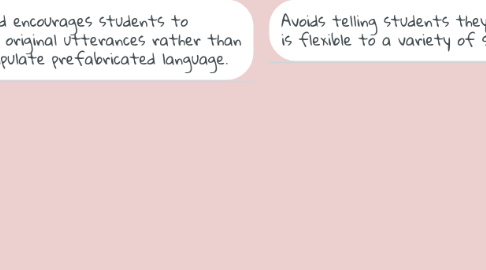
1. Entailed repetitive language drills and can be referred to as "drill and practice"
1.1. Drill and practice courseware is based on the model of computer as tutor (Taylor, 1980).
1.2. The computer serves as a vehicle for delivering instructional materials to the student.
1.3. Rationale behind drill and practice was not totally spurious, which explains in part the fact that CALL drills are still used today.
1.3.1. Repeated exposure to the same material is beneficial or even essential to learning
1.3.2. A computer is ideal for carrying out repeated drills, since the machine does not get bored with presenting the same material and since it can provide immediate non-judgmental feedback
1.3.3. A computer can present such material on an individualized basis, allowing students to proceed at their own pace and freeing up class time for other activities
2. Behavioristic CALL
2.1. Based on the then-dominant behaviorist theories of learning
2.2. The PLATO system
2.3. Ran on its own special PLATO hardware, including central computers and terminals.
2.3.1. vocabulary drills
2.3.2. Brief grammar explanations and drills
3. Integrative CALL
3.1. 2 important technological developments of the last decade
3.1.1. Internet
3.2. Internet
3.2.1. Computer-mediated communication (CMC)
3.2.1.1. Allows users to share not only brief messages, but also lengthy (formatted or un-formatted) documents--thus facilitating collaborative writing--and also graphics, sounds, and video.
3.2.1.2. Using the World Wide Web (WWW), students can search through millions of files around the world within minutes to locate and access authentic materials
3.2.1.3. Use the Web to publish their texts or multimedia materials to share with partner classes or with the general public.
3.3. 3 Technological tool
3.3.1. E-mail Communication
3.3.1.1. The Bulgarian students correspond by e-mail with an American class of TESOL graduate students to explore in detail the nuances of American culture which are expressed in the stories, and also to ask questions about idioms, vocabulary, and grammar.
3.3.1.2. The American students, who are training to be teachers, benefit from the concrete experience of handling students' linguistic and cultural questions .
3.3.2. Concordancing
3.3.2.1. The Bulgarian students further test out their hypotheses regarding the lexical and grammatical meanings of expressions they find in the stories by using concordancing software to search for other uses of these expressions in a variety of English language corpora stored on CD-ROM
3.3.3. Audiotape
3.3.3.1. Selected scenes from the stories -dialogues, monologues, and descriptions-- were recorded by the American students and provide both listening practice (inside and outside of class).
3.3.3.2. Additional background materials to help the Bulgarians construct their interpretation of the stories
3.4. Multimedia Computers
3.5. Hypermedia
3.5.1. Provides a number of advantages for language learning
3.5.1.1. Authentic learning environment is created
3.5.1.2. Skills are easily integrated
3.5.1.3. Students have great control over their learning
3.5.1.4. Facilitates a principle focus on the content, without sacrificing a secondary focus on language form or learning strategies
3.6. Several major problems have surfaced
3.6.1. Question of quality of available programs
3.6.1.1. Teachers themselves can conceivably develop their own multimedia programs using authoring software.
3.6.1.1.1. Hypercard (for the Macintosh)
3.6.1.1.2. Toolbook (for the PC)
3.7. Example of how hypermedia can be used for language learning is the program Dustin which is being developed by the Institute for Learning Sciences at Northwestern University (Schank & Cleary, 1995)
3.7.1. A simulation of a student arriving at a U.S. airport.
4. Allows and encourages students to generate original utterances rather than just manipulate prefabricated language.
5. Communicative CALL
5.1. Based on the communicative approach to teaching
5.1.1. Focuses more on using forms rather than on the forms themselves
5.1.2. Teaches grammar implicitly rather than explicitly
5.1.3. Does not judge and evaluate everything the students nor reward them with congratulatory messages, lights, or bells
5.1.4. Uses the target language exclusively and creates an environment in which using the target language feels natural, both on and off the screen
5.1.5. Will never try to do anything that a book can do just as well
